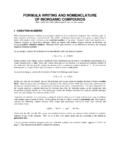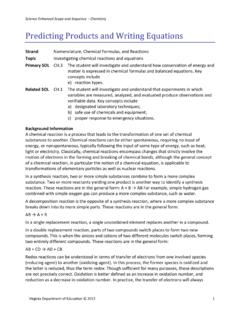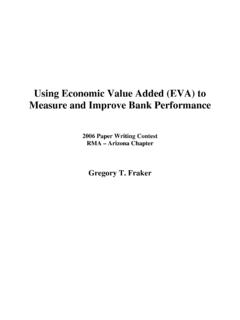Transcription of Allocation of Capital in the Insurance Industry
1 1 Allocation of Capital in the Insurance Industry J. David CUMMINS The Wharton School 1. Introduction The purpose of this article is to provide an overview of the various techniques that have been suggested for allocating equity Capital . Capital Allocation in this context refers to the determination of the amount of a firm's equity Capital that is assigned to each project or line of business undertaken by the firm. The objectives of Capital Allocation are discussed in more detail below. However, firms are usually concerned about Capital Allocation in the context of pricing and project selection, , to determine the proportion of the firm s overall cost of Capital that must be contributed by each line of business in order to maximize firm value.
2 The discussion of Capital Allocation is conducted in the context of the Insurance Industry . However, most of the techniques discussed are perfectly general and can be applied in other industries as well. Capital Allocation is perhaps of special interest to financial firms such as insurers. For such firms, the principal providers of debt Capital ( Insurance reserves) are also the firm s principal customers. Unlike the holders of bonds and other (non- Insurance ) debt Capital , Insurance policyholders cannot protect themselves against the insolvency of specific debt issuers by holding a diversified portfolio.
3 Unlike the diversified bond investor, the typical policyholder relies upon one insurer (or at most a few, in the case of life Insurance ) for each type of protection purchased ( , auto Insurance , homeowners Insurance , health Insurance , etc.). Most Insurance policies are purchased not as an investment but to protect against adverse financial contingencies. Thus, insolvency risk plays a special role in the Insurance Industry , and Capital is held to assure policyholders that claims will be paid even if larger than expected. This paper is based on a presentation by the author at the SCOR Reassurance Symposium on Capital Allocation , Paris, France, October 1998.
4 It is published in the Risk Management and Insurance Review (2000) 3: 7-28. 2In discussing Capital Allocation , it is important to keep in mind that the insurer s entire Capital is available to pay the claims arising from any specific policy or line of business. If the insurer becomes insolvent it is the entire company that enters bankruptcy the firm does not go bankrupt line by line. Nevertheless, it is often useful to think of Capital as being allocated by line of business for pricing, underwriting, and other types of decision making.
5 Taking a close look at Capital Allocation in the context of the Insurance Industry is also useful to elucidate the interaction between financial decision making and the risk-based Capital rules applied to the Insurance Industry by regulators. Capital Allocation is also related to recently emerging concepts such as risk adjusted return on Capital (RAROC) and economic value added (EVA), which have become important management decision making techniques for both financial and non-financial firms. Before beginning the discussion of Capital Allocation , two cautionary notes are in order: first, the terminology in this field is far from standardized.
6 Therefore, a concept such as "risk-adjusted return on Capital " that I will discuss is sometimes called by slightly different names in the literature. It is important to focus on the concepts and not on the nomenclature. Second, because this is an overview, it omits many important details that a firm would have to deal with to allocate Capital in practice. Filling in the details to enable insurers to move from the concepts to practical applications in Capital Allocation provides a promising avenue for future research. The remainder of the article is organized as follows: Section 2 discusses how Capital Allocation can be used to maximize the value of the firm.
7 Section 3 first provides an overview of the Capital Allocation techniques that have been suggested and/or employed in practice and then provides a detailed discussion of the principal methods. Section 4 concludes. 2. Using Capital Allocation to Maximize Value Why allocate Capital ? The motivation for anything a firm does should be to maximize shareholder value, that is, to increase the market value of equity Capital . Unfortunately, this 3straightforward and powerful objective is often overlooked in practice.
8 Through extensive discussions with people in the Insurance Industry , it appears that many firms are managing to their GAAP (generally accepted accounting principles) balance sheets and income statements, with the objective of showing healthy GAAP earnings and/or maximizing the value of GAAP equity. Of course, the firm needs to be cognizant of its GAAP performance because of the importance of accounting results to financial analysts and traders. However, it is a mistake to lose sight of the firm s true mission the maximization of market value.
9 Marking to market should play a critical role in the firm's internal decisions. Capital Allocation can be used to facilitate and improve the measurement of the economic profitability of businesses with different sources of risk and different Capital requirements. In the Insurance Industry , it is customary to define businesses in terms of lines of Insurance , for example, the commercial liability line or the auto liability line. Although this is the traditional approach, insurers need to step back and think carefully more about the issue of what is a business?
10 In designing Capital Allocation and performance measurement systems. Sometimes the banking literature talks about deposit accumulation or gaining demand deposits as one business, and making loans as another business. In this conceptualization, the economic concept of transfer pricing is used, whereby the bank s loan origination business will borrow money from the deposit accumulation business and pay an implicit rate of interest in return for having funds to invest in loans. This approach could also be used in Insurance . The underwriting operation could be considered as a funds-generating business in which money is being borrowed from policyholders.








